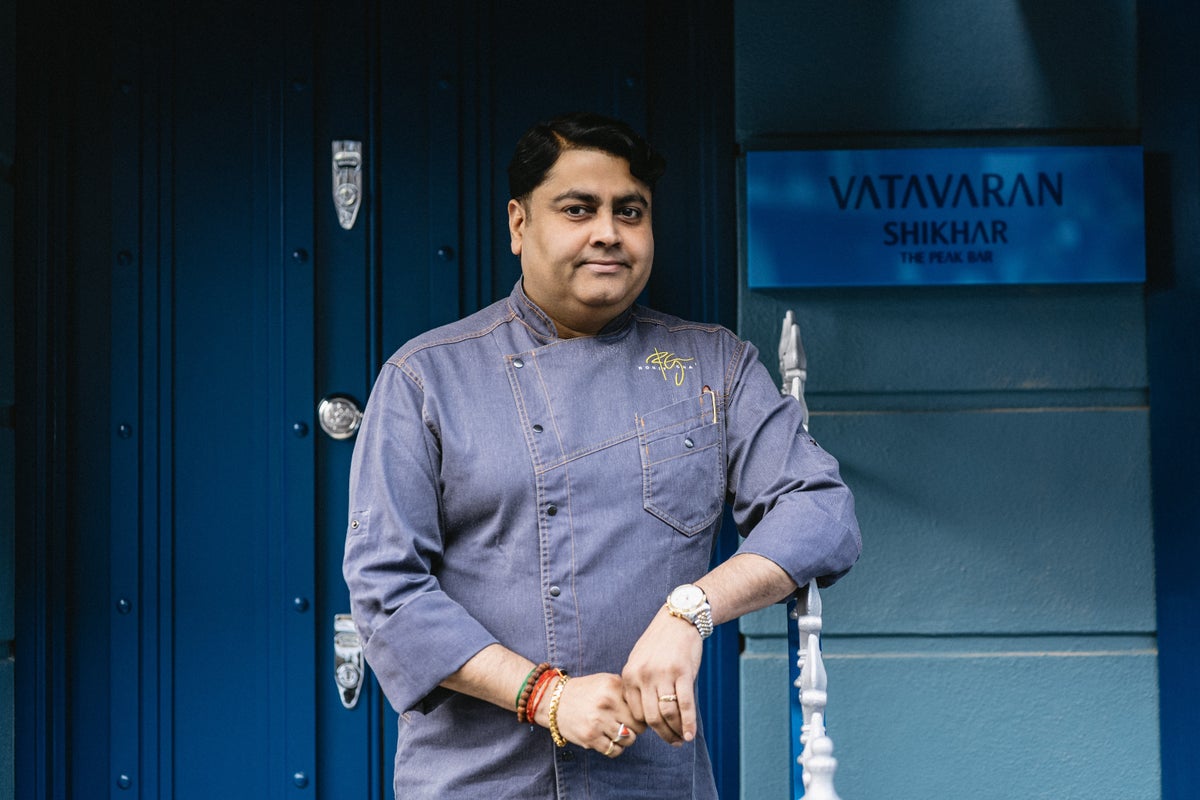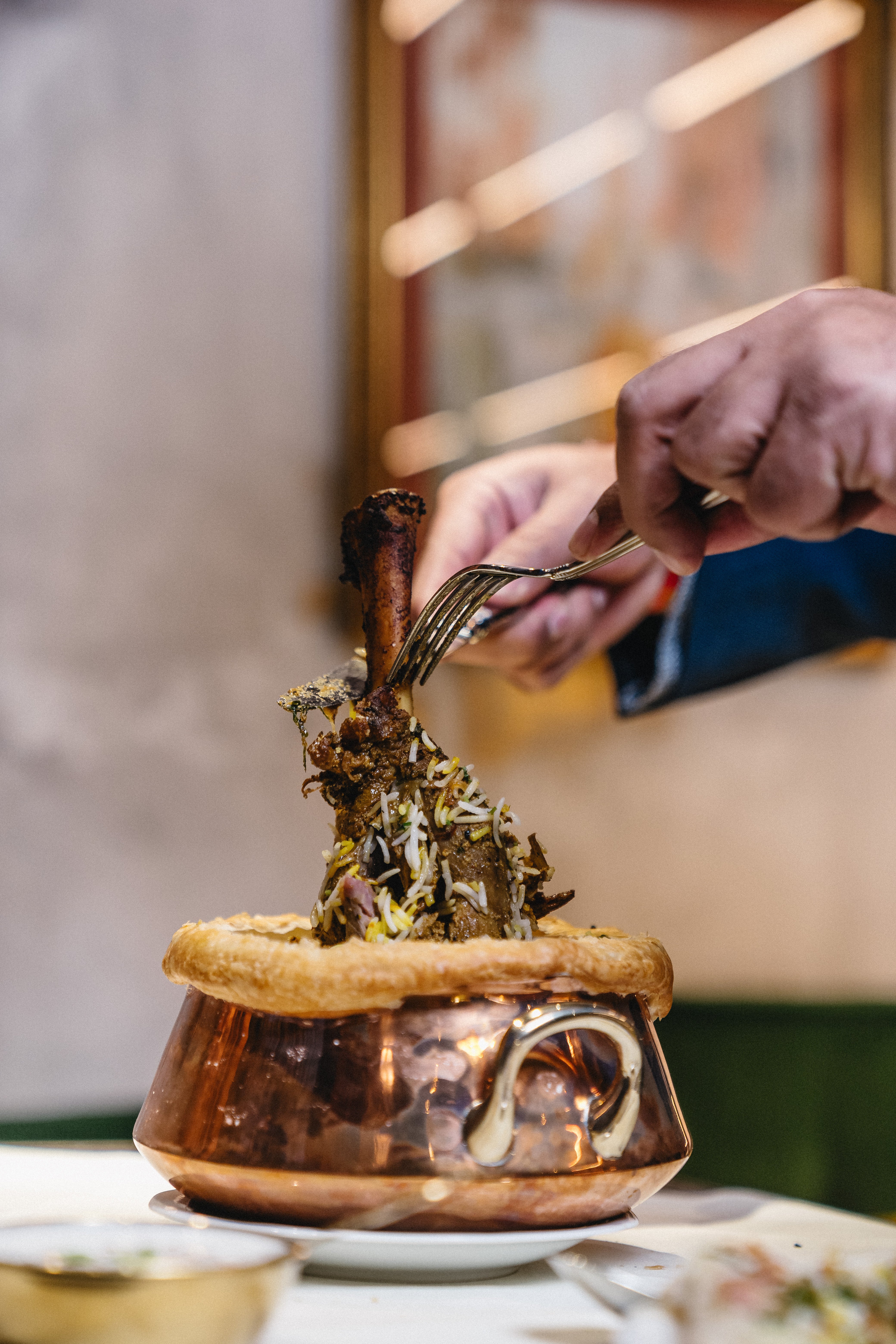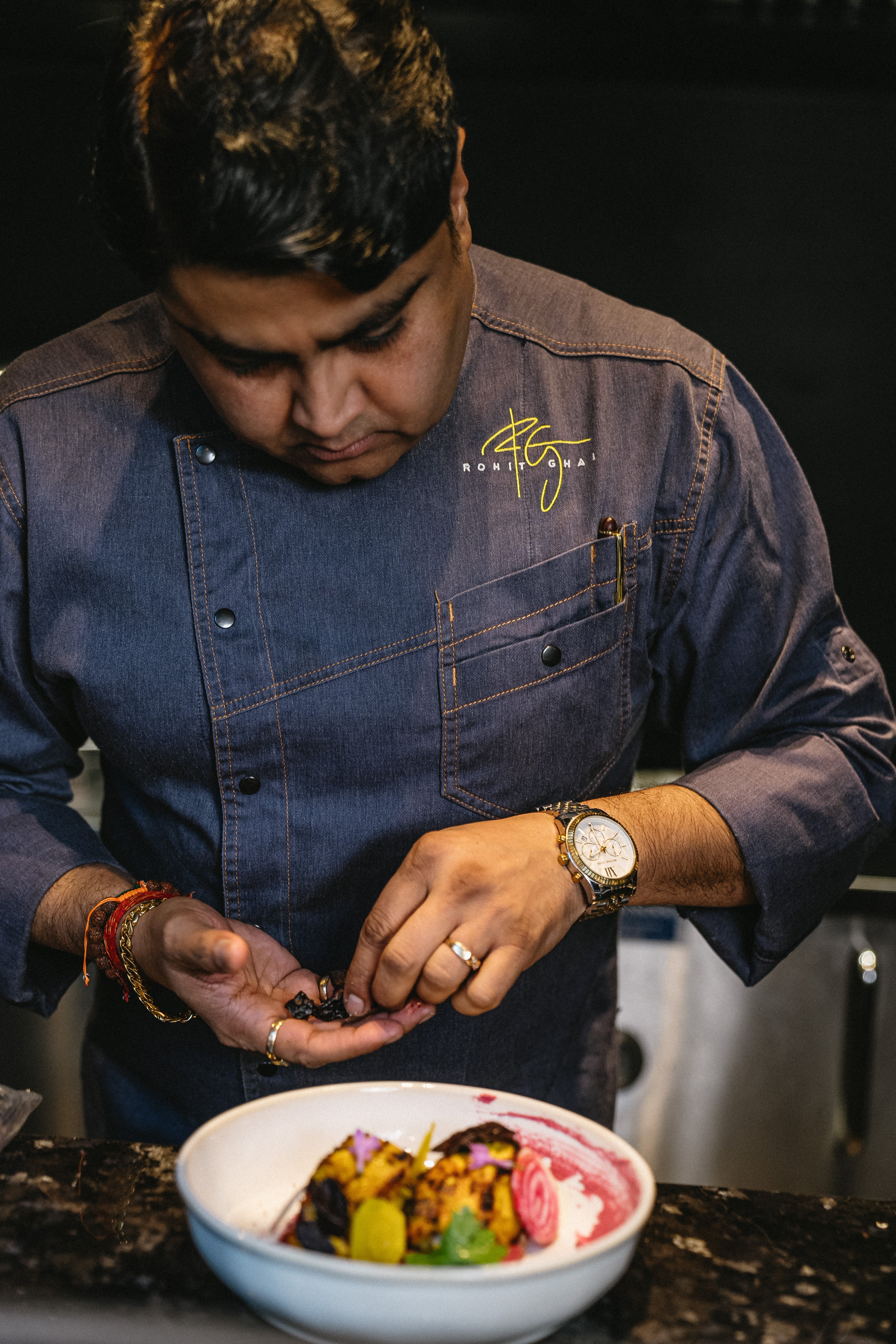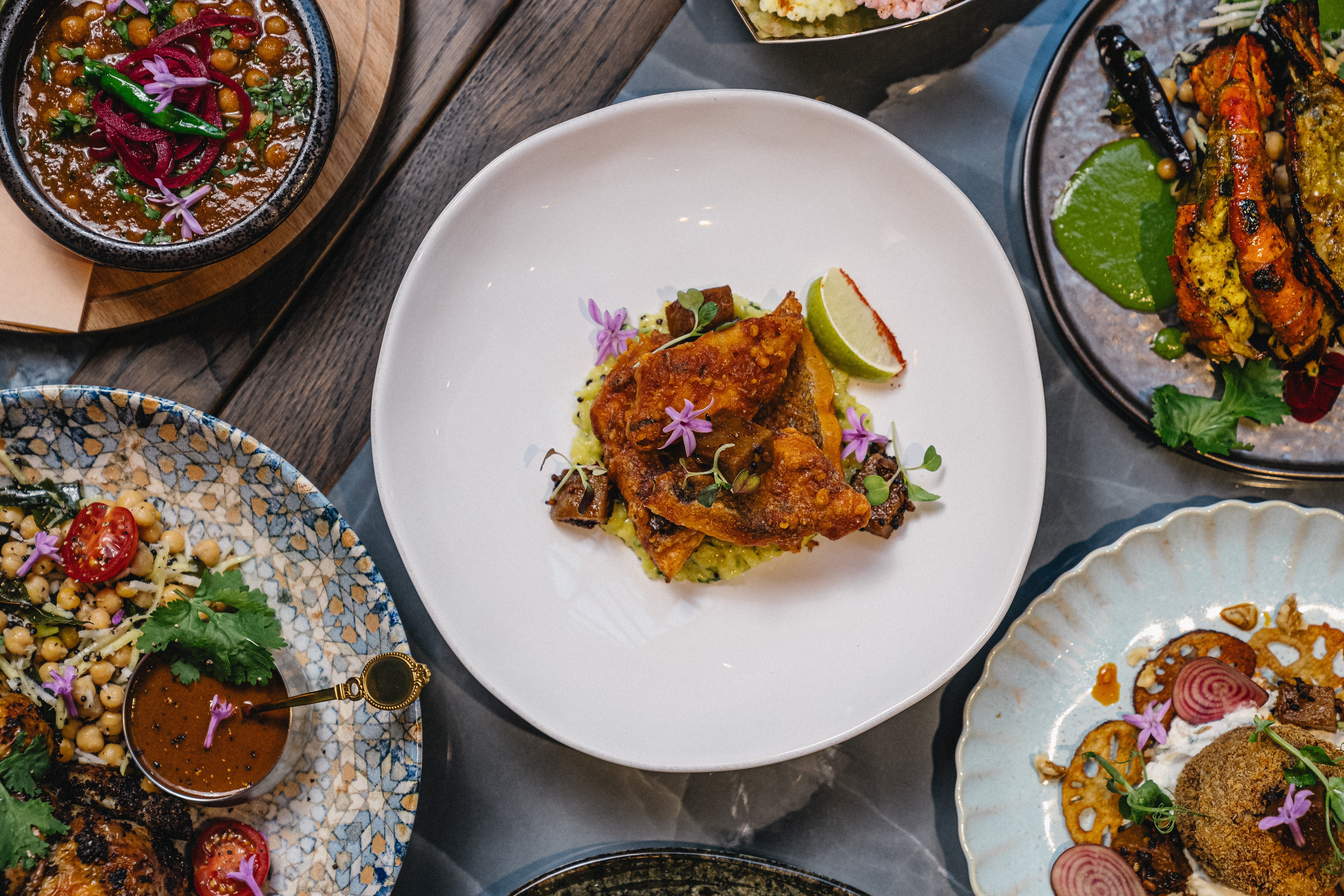
Carefully cutting around a pastry top, it’s lifted off the bowl to reveal a lamb shank leg inside – the tender meat effortlessly falling off the bone as it’s removed and mixed into the rice.
This is a traditional Kolkata-style biryani, made in a clay pot, with saffron, baby potatoes and fresh plums, and sealing with dough helps keep the steam in and the rice moist while the lamb slow cooks.
“There are about 18 to 20 variations of biryani in India. This is a different style to what we normally cook on the north side of India,” says chef Rohit Ghai on the newly-opened Vatavaran in London.
“I think a lot of people’s only experience [of biryanis] is Indian takeaways or most people, they make biryani the North Indian-style – there are two versions that are very common. But if you dig into it, you come to know that every single region has their own kind of biryani.”
On the island of Goa, the local biryani is made with prawns, for example. “In Kerala, south India, there’s a small Muslim community and they make their own biryanis, while the Brahmin people [a Hindu group] also make their own,” explains the 42-year-old, who has also worked under with Atul Kochhar – the first-ever Indian chef to win a Michelin star in the UK in 2001.
“Hyderabadi is the most popular biryani [from the state of Telangana] they make it in layers – some is started with raw rice and raw meat, that’s the most special, unique thing for hyderabadi biryani. They call it Kachay Gosht – meaning raw mutton and raw rice.”
Ghai, who is considered to have been a big part of the transformation of the Indian fine dining scene, with a growing group of London restaurants, including Jamavar – which gained a Michelin star within 10 months of opening – Manthan and Kutir, as well as restaurants in Oman, Morocco and Qatar.
The interior of the new multi-storeyed Vatavaran (its name meaning “atmosphere” in Sanskrit) is inspired by elements of the Himalayan landscape, with a low-lit cocktail bar, Shikhar, at the very top – the word translating to mountain peak. On the menu you’ll find some pan-Indian textbook classics, alongside Ghai’s signature lamb shank biryani, whole rotisserie masala chicken with bone marrow sauce and a sea bass “reachaedo” with Goan spices.

While Ghai is all about elevating Indian cuisine – “I know where we can slightly tweak without compromising with the flavours, because Indian food is all about flavours” – he believes any home cook can learn to make great Indian food, but you do need time.
“To be honest, Indian food is very easy to make, but it is time consuming. It’s quite a process, it’s quite lengthy. You only need onions, tomatoes and garlic, which you can get everywhere, it’s not rocket science but you have to have patience.
“Caramelising onion, it’s long, especially for north Indian food, it takes a little while because you have to caramelise the onion properly and that’s the hardest part.”
From dals and biryanis to chicken, caramelised onion features in many classic Indian dishes – and the slow cooking releases the vegetable’s natural sugars.
“To reduce the timing, I always recommend always using a little salt – it will speed up the process,” he suggests. “If you have patience, your final product will be outstanding.”
Born in Gwalior, a city in the mid-North of India, to Punjabi parents, Ghai grew up in a household with 13 people, as one of four siblings but his uncle’s family also lived in the same home. “I spent a lot of time between the Punjab and north India,” he says, so much of his food reflects these regions.
As the youngest in the family, he would spend a lot of time during school holidays with only his mum. “She is the absolute cook,” Ghai says, whose father died two years ago. His parents were vegetarian and raised their children that way too. “In the old days you hardly got any takeaways or anything. On special occasions we used to go out to try different places, but most of the time it was homemade.

“Every day she used to make some dishes from Punjab. Being Punjabi we used to have a heavy breakfast – parathas are very popular – so every single day she used to make stuffed parathas with potatoes, cheese, sometimes spinach, handmade with a dollop of butter. It was rich food.”
He remembers learning to cook with his mum during summers with temperatures peaking around 45C, although nowadays they can reach 50. “I still remember when I was a kid I used to make a lot of little triangle parathas, that’s very common in all households in India,” he says, and they’re on the menu at his Manthan eatery. “You need to crush it with both hands and you will see the layers, it’s very crunchy and crusty.”
After school there was “no plan for hospitality” but he found himself at cookery college, where the restaurant industry seemed “very glamorous” and he trained at Oberoi Hotels.
Ghai says: “We started in the morning and there was no finish time – 14 or 15-hour days. But after college the main agenda was to get a good break from one of the big hotel chains – in those days if you started your career with a standalone restaurant there were restrictions for you. But the Taj was top notch. It was a very difficult task to get into a hotel abroad [though].”
After a couple of years he told the senior staff that his “dream city” was London. “In our industry London is one of the biggest foodie hubs and all of the legendary chefs are from Europe.”
Although he was training in Western fine dining, he convinced a senior chef to spend time to help him learn and understand Indian food. “After finishing my regular shift in Western food, I used to spend a couple of hours every single day in an Indian kitchen.”

His breakthrough was with the Taj group, whose expertise was Indian cookery. “The early days were really tough for me – a lot of hard work on unlimited working hours.”
In 2008 an opportunity arose to work with Kochhar at London’s famous Indian Michelin star kitchen – Benares. “It was eye-opening for me,” says Ghai. “Fifteen or 20 years back, there was a huge difference between the Indian market and European market.”
Your local Indian might not be showcasing the best of the cuisine, Ghai suggests. “The Europeans love to have their curry nights but there are 300 dishes on the menus of curry houses – the base will be the same and they use edible colours to make it different. When you order four things together you hardly find any difference.
“Indian food has a lot of depth and it’s a vast country” – and he’s determined to do it justice.
Rich, buttery, deeply comforting – this is butter chicken done properly
Charred, glazed, spiced – this is hispi cabbage like you’ve never had it
Sweet, sour, spicy – this Mangalorean fish curry does it all in one pot
What Brits get wrong about Turkish BBQ – and how to do it properly
Why it’s time to ditch lamb and try this at Easter instead
From chippy eggs to kimchi: Meet the man behind Britain’s pickle obsession







